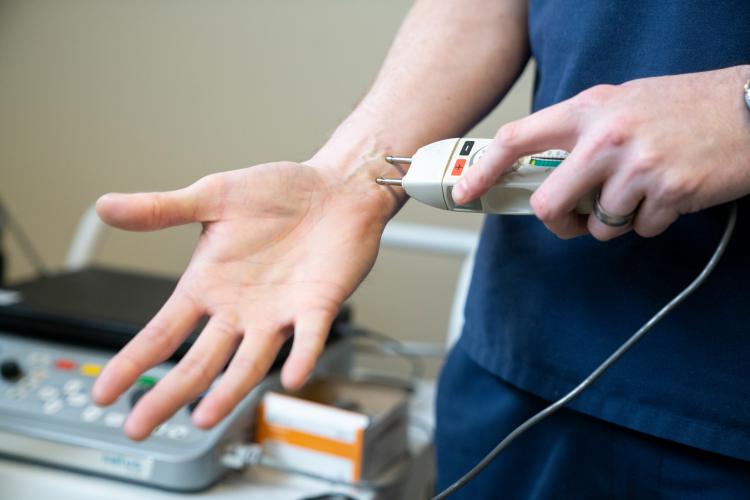
When patients have questions about seizures, nerve issues or breathing problems, the team in the JPS Health Network Neurodiagnostic Testing Department is dedicated to finding the answers their doctors need to make them better.
Machines operated by experienced physicians and technicians can track down the source of the troubles, helping to fine tune medication or, in some cases, directing surgeons where to work to give the patient relief.
“We have three different types of testing to investigate three completely different disease processes,” said Jim Graves, Executive Director of Respiratory Therapy and Neurodiagnostics, said. “It’s an amazing way to get to the source of a patient’s problems and get them the care they need.”
The three tests done in Neurodiagnostic Testing are:
Electroencephalogram
An electroencephalogram, or EEG, is a device that detects and tracks electrical activity in the brain. Small, electrodes are attached to the scalp in a grid pattern to determine how electrical impulses travel with the results displayed as wavy lines on a screen, according to EEG technician Kevin Morris.
An EEG is a primary diagnostic test for epilepsy, but it can also play a role in diagnosing and analyzing other brain disorders including tumors, damage from head injuries, encephalitis, strokes or sleep issues.
Patients who have problems with seizures are asked to look at a light that strobes in different patterns. Morris said by watching their brain activity on his monitor as the strobe goes through its program, he can determine what triggers seizures so doctors know what medicine to prescribe to control them.
Often people go through EEG testing to verify their seizures are controlled in order to qualify them to drive a car. Morris said, according to Texas law, a person must be seizure free for three months before they’re allowed to get back behind the wheel.
Electromyography
When patients experience numbness or muscle weakness, Electromyography (EMG) measures muscle response or electrical activity in response to a nerve’s stimulation of the muscle. During the test there are two different ways to stimulate the muscle. Sometimes a device that looks like a stun gun is used to pass electrical impulses through the skin. On other occasions, one or more small needles are inserted through the skin into the muscle. The electrical activity picked up by the electrodes is then displayed on an oscilloscope, a monitor that displays electrical activity in the form of waves. An EMG measures the electrical activity of muscle during rest, slight contraction and forceful contraction.
“Impulses travel from the fingertips through the nerves and up to your brain,” Graves explained. “They should be traveling at a known speed. If they’re traveling too slowly, we can use that information to identify certain disease types.”
Pulmonary Function Testing
These tests measure lung size and air flow, lung volume, how well gases such as oxygen get in and out of your blood and for signs of inflammation in the lungs, according to respiratory therapist Scott Westbrook.
Testing includes pulse oximetry and arterial blood gas tests and fractional exhaled nitric oxide testing that detects inflammation in the lungs. Patients usually have one or more of these tests to diagnose lung and airway diseases and then they may repeat the tests later as a way to measure the effectiveness of treatments.
“Patients can be tested, then receive treatment or medication and, after that, come back to be tested again to measure how they’re responding,” Graves said. “It’s a very helpful tool to fine tune treatment plans to help patients.”
If you haven’t heard about the Neurodiagnostic Testing Department before, don’t be surprised. Morris said the people who work the machines don’t want a lot of foot traffic in the area. They try to keep it as quiet there as possible because noise and commotion can disrupt the tests.
Graves said it’s not a job that gets a lot of fanfare. But the work done in the lab is extremely helpful in getting patients better.
“It’s not a very high profile job,” Graves said of the department. “But the people there do a great job for our patients.”
